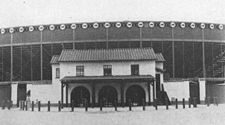Buff Stadium | |
 Facade of Buffalo Stadium, ca. 1948 | |
 | |
| Full name | Buffalo Stadium |
|---|---|
| Former names | Busch Stadium (1958–1963) |
| Location | Houston, Texas |
| Owner | St. Louis Cardinals (1928–1958) Anheuser-Busch (1958–1960) William Hopkins (1960–1961) Houston Sports Association (1961–1963) |
| Capacity | 11,556 (1928–1938) 14,000 (1938–1963) |
| Field size | LF 344 CF 440 RF 344 |
| Surface | Grass |
| Construction | |
| Opened | April 11, 1928 |
| Renovated | 1938, 1948 |
| Closed | October 15, 1961[1] |
| Demolished | 1963 |
| Construction cost | $400,000 ($7.1 million in 2023 dollars[2]) |
| Architect | Henry R. Jones & Tabor[3] |
| Tenants | |
| Houston Cougars baseball (NCAA) 1947 Houston Eagles (NAL) 1949–1950 Houston Buffaloes (TL, AA) 1928–1961 Texas Southern Tigers football (NCAA) 1947–1951 | |
Buffalo Stadium was a minor league stadium primarily used by the Houston Buffaloes from 1928 through 1961 (except for 1943 to 1945 because of World War II).[citation needed] It was the site of the first night game between two major league baseball clubs, which took place between the Chicago White Sox and New York Giants in 1931. The Buffaloes were a farm team of the Major League St. Louis Cardinals and provided many great ballplayers to the Cardinals' success in 1930s and 1940s. The arrival of the National League Houston Colt .45s in 1962 brought an end to minor league baseball in Houston. It also went by the names of Buff Stadium and later Busch Stadium. It was bounded by Leeland Street, St. Bernard Street (present-day Cullen Boulevard), Coyle Street, and Milby Street in the East End.[4] The railroad tracks leading to Union Station, site of the Houston Astros' current ballpark, ran behind the center field wall. Near the University of Houston, the stadium was also home to the Houston Cougars baseball team during the 1940s.
Before Buff Stadium, baseball teams in Houston played at West End Park from 1905 until 1928; Buff Stadium was built on the East End of Houston.[5] West End Park was located at the southeast corner of Andrews and Heiner Streets, on the southwest edge of present-day downtown.[6] Home plate's specific location, until 2013, was commemorated by a plaque in the Houston Sports Hall of Fame, which comprised part of the Finger Furniture Store.
- ^ "Major League Stars Card Final in Busch Stadium". Baytown Sun. October 12, 1961. p. 7.
- ^ 1634–1699: McCusker, J. J. (1997). How Much Is That in Real Money? A Historical Price Index for Use as a Deflator of Money Values in the Economy of the United States: Addenda et Corrigenda (PDF). American Antiquarian Society. 1700–1799: McCusker, J. J. (1992). How Much Is That in Real Money? A Historical Price Index for Use as a Deflator of Money Values in the Economy of the United States (PDF). American Antiquarian Society. 1800–present: Federal Reserve Bank of Minneapolis. "Consumer Price Index (estimate) 1800–". Retrieved February 29, 2024.
- ^ "Buffalo Stadium is Termed Most Complete Stadium in Country By Architect". Houston Chronicle. April 10, 1928. p. 14, sec. Buffalo Stadium.
- ^ 1935 Houston Map showing location of Buffalo Stadium as "Ball Park"
- ^ From Buffs to Astros, Houston keeps going to bat for baseball - Houston Business Journal:
- ^ 1913 Map of Houston indicating location of West End Park as "Ball Park"